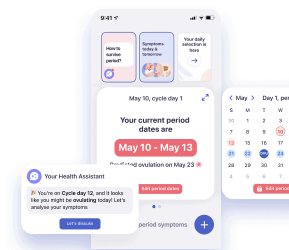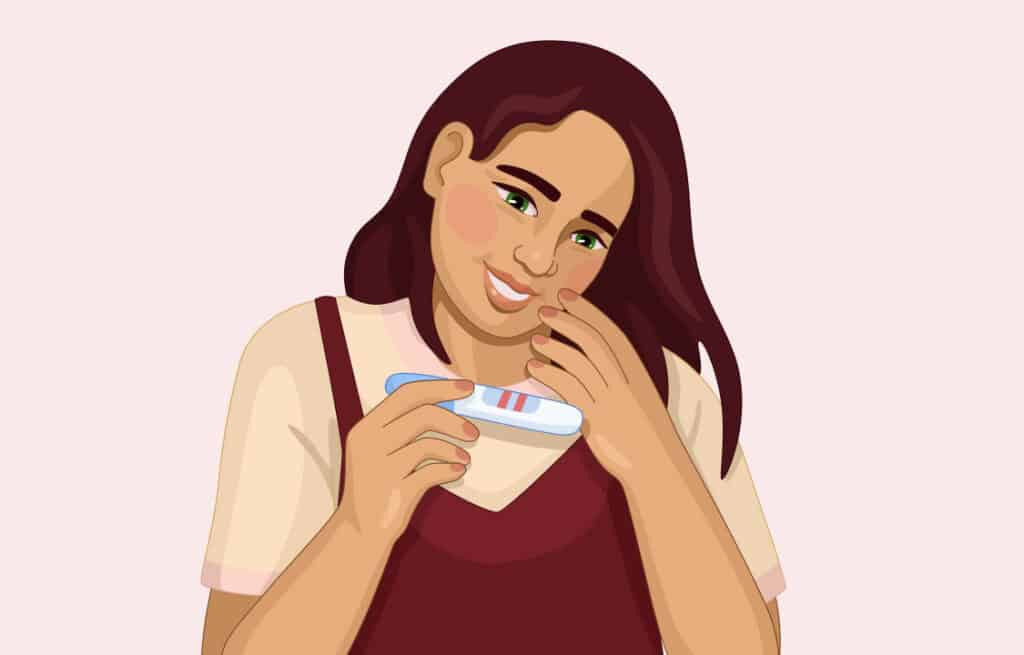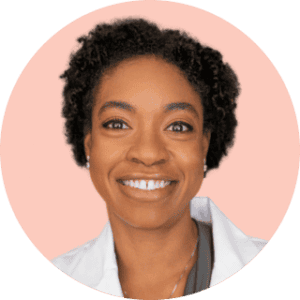Femia > Health Library > Your cycle > Health > Understanding the luteal phase: symptoms, mood, and what to eat
Understanding the luteal phase: symptoms, mood, and what to eat

- Updated Mar 2, 2025
- Published
CRAFTED BY HUMAN
Crafted by human At Femia, we provide accurate and up-to-date information at every stage of your journey, from trying to conceive, pregnancy and postnatal support. All content is created by a real person based on in-depth research and own professional experience. Femia ensures that you will receive expert advice, strict accuracy and a personalized approach from our authors/medical experts. Learn more about our editorial policy.
FACT CHECKED
Fact checked At Femia Health, we maintain the highest standards of editorial excellence in delivering content focused on helping you conceive, guiding you through pregnancy, and supporting you postpartum. Explore our content review principles to learn how we ensure the accuracy and quality of our health and lifestyle tips for every stage of your journey.
The luteal phase is a stage in the second half of the menstrual cycle that follows after the ovulation and lasts until your next period. The increased progesterone production during this stage often results in symptoms like:
- Breast tenderness
- Bloating
- Changes in your appetite
- Breaking out or acne
- Mood swings
- Changes in your discharge
Managing these symptoms is possible with the help of a nutrient-dense diet filled with magnesium-rich foods, complex carbs, calcium, vitamin B6, as well as proper hydration, stress-management activities, and mild exercise.
The luteal phase is one of the four stages of your menstrual cycle. Following right after ovulation, this phase plays a crucial role in egg implantation and subsequent pregnancy.
To prepare you for a potential pregnancy, your body releases more progesterone as it enters the luteal phase of the menstrual cycle. Increased progesterone levels lead to uterine lining thickening and can cause bloating, changes in appetite, mood swings, and other symptoms.
In this article, we’ll tell you more about the luteal phase of the menstrual cycle, its symptoms, and recommendations for managing its symptoms.

What is the luteal phase?
The luteal phase is a stage in the second half of the menstrual cycle. It begins after ovulation and continues until your next period. This phase is pivotal for your reproductive system as its primary purpose is to prepare your uterus for a possible pregnancy.
What happens during the luteal phase
In the ovulation, your ovary releases an egg. When you enter the luteal phase, the egg travels through the fallopian tube to get to the uterus. If it was fertilized during the ovulation, the egg will implant into your uterine lining marking the start of the pregnancy. If the egg isn’t fertilized, it will be reabsorbed into your body instead of implanting and you will get your period.
On the hormonal level, the beginning of your luteal phase is associated with peaking progesterone levels. After ovulation, the dominant follicle that releases an egg transforms into the corpus luteum–a temporary collection of cells formed during each menstrual cycle. The corpus luteum produces progesterone, which thickens the endometrial lining of your uterus, making it a healthy place for subsequent implantation and pregnancy.
When is the luteal phase?
The luteal phase of the menstrual cycle begins right after you ovulate. In a 28-day menstrual cycle, it happens around the 14th day. However, the length of every person’s cycle is unique so the actual start of the luteal phase is determined based on your individual cycle. The duration of this phase is also individual but typically it lasts about 10-16 days.
👉Find out more: Hyperovulation: You can ovulate twice in a month?
Luteal phase symptoms: What to expect

The symptoms of the luteal phase may resemble those that you may have during your premenstrual syndrome (PMS). These include:
- Breast tenderness
- Bloating
- Changes in your appetite
- Breaking out or acne
- Mood swings
- Changes in your discharge
Most of these symptoms are caused by changing hormonal levels and progesterone, in particular. The severity of these symptoms can vary greatly from one person to another. Some females may have more tangible luteal phase symptoms, whereas others may not notice them at all.
Luteal phase discharge
Changing vaginal discharge is one of the symptoms that can let you tell you’re in your luteal phase. During this time, rising progesterone levels make your cervical mucus thicker and creamier. Thicker discharge during the luteal phase performs several important roles –1) it acts as a barrier to prevent sperm from getting into your upper reproductive tract, and 2) it also keeps bacteria, fungi, and infections from reaching the uterus where a fertilized egg might be implanting.
Luteal phase mood: How hormones affect emotions
Changes in mood – like anxiety, irritability, and feeling more withdrawn – are rather common during this stage of your cycle. Luteal phase mood swings are caused by changes in hormones. Progesterone that rises during this time is known to affect emotion processing both in the brain and at the behavioral level.
Emotional processing includes the detection and evaluation of external stimuli. During the progesterone-dominant luteal phase, the accuracy of emotion recognition becomes poorer. Studies show that during this time, many females demonstrate a negative bias in emotion recognition and tend to respond faster to negative stimuli rather than positive.
Feeling these emotional fluctuations is normal. You can leverage stress-reducing activities and routines that work for you to make this period more emotionally comfortable. For example, you can practice mindfulness, gentle exercise, meditation, etc.
Foods to eat during luteal phase: supporting your body
The luteal phase of your cycle can be accompanied by mood swings and physical symptoms that can cause you discomfort. Choosing the right foods during this time can help you alleviate the symptoms and feel better.
Magnesium-rich foods
Products with high magnesium content, such as dark leafy greens, seeds, nuts, and beans, can help maintain the proper levels of different minerals in your body, including potassium, calcium, and zinc.
Complex carbs
Complex carbs, such as sweet potatoes, pumpkin, squash, lentils, and potatoes, are rich in fiber and contain three or more natural sugars. They cause a moderate rise in insulin levels, helping you stabilize your mood and gain control over food cravings.
👉Find out more: Cycle syncing diet: What to eat during each phase of your menstrual cycle
Iron-rich foods
Eating foods rich in iron, such as lean meats, helps you increase your iron intake before your next period to replace the iron your body loses.
Calcium/low-fat dairy
Calcium is known to reduce mood swings during PMS. Hence, integrating foods like yogurt, soy products, milk, and low-fat cheese might be helpful for stabilizing your mood during the luteal phase as well.
Vitamin B6 products
Vitamin B6 is also known for its beneficial mental properties. Foods that contain it, such as sweet potatoes and bananas, can help you lower irritability and anxiety.
Luteal phase foods to manage bloating and hydration
If you’re feeling bloated, supplement your diet with products rich in potassium, such as avocados and bananas. Also, remember to stay properly hydrated to reduce bloating, brain fog, and other symptoms.
Things to avoid
To stabilize energy and mood and manage other luteal phase symptoms, consider limiting alcohol and caffeine intake. Also, consider eating less salt and processed food to prevent bloating and swelling.
Sex during luteal phase: Libido and intimacy
The sexual desire or libido in women is modulated by three ovarian steroids – estradiol, testosterone, and progesterone. Among these steroids, progesterone is a negative predictor of sexual desire. Hence, the rising levels of progesterone in the luteal phase are frequently associated with suppressed libido, albeit not in every woman.
If you’re experiencing a lowered libido, this is natural but it doesn’t mean that there is nothing you can do about it. To maintain desire and intimacy during this stage of your cycle, consider using the following tips:
- Eat nutrient-dense foods, stay hydrated, and maintain appropriate physical activity to keep your mood and energy levels high.
- Implement stress relief and self-care rituals for well-being.
- Focus on emotional connection and nurture your relationships.
- Don’t neglect the foreplay to give yourself enough time to get started.
- Consider using toys or suitable poses to help you reach an orgasm.
- Don’t hesitate to use extra lube if you’re experiencing dryness.

Can you get pregnant during the luteal phase?
Generally, the luteal phase follows after your fertility window and your best chances of conception occur in the follicular phase of your cycle, when you’re most fertile. However, though it’s less likely, pregnancy can still occur in the luteal phase.
When you enter this phase of your cycle after ovulation, you still have 12 to 24 hours when the egg can be still fertilized. Also, pregnancy can happen if ovulation timing is miscalculated. All in all, an understanding of your individual cycle and its timing is the key to either preventing or planning pregnancy.
Questions from the Femia community
Why do I feel more bloated during the luteal phase?
During the luteal phase, progesterone levels are rising, making it your predominant hormone. Progesterone can cause slower digestion and enhanced fluid retention, leading to more pronounced bloating.
Can exercise help manage mood swings in the luteal phase?
Yes, light, low-impact exercising can be a powerful way to reduce stress. Physical activity helps boost the production of endorphins – your brain’s feel-good neurotransmitters. Thus, walking or doing yoga can help you stabilize your mood.
What does it mean if my luteal phase is shorter than 10 days?
A luteal phase that lasts less than 10 days is considered too short to allow your uterine lining to grow and thicken enough for seamless implantation. It might be caused by hormonal imbalance and become a hurdle on your way to getting pregnant. It might also be a sign of a luteal phase defect (LPD). Consider consulting a healthcare provider.
The bottom line
Taking place in the second half of your menstrual cycle, the luteal phase is when an egg travels to the uterus and implants if it is fertilized to mark the beginning of pregnancy. During this phase of your cycle, your body prepares for potential implantation and produces an increased amount of progesterone, which often leads to mood swings, bloating, breast tenderness, and other symptoms, many of which resemble PMS.
Although the severity of luteal phase symptoms can vary greatly from one woman to another, knowing how to manage them right can help you feel comfortable and well during this stage of your cycle. As you already know from our guide, a big part of symptom management is proper nutrition and lifestyle choices. It’s recommended to support your body with rich foods that supply you with magnesium, iron, potassium, vitamin B6, and other nutrients.
Also, it’s recommended to maintain low-impact physical activity and integrate stress-relieving activities into your daily life to help promote well-being. Use the knowledge you’ve gained from this guide to make the luteal phase of your cycle worry-free and don’t hesitate to track your cycle and delve into its different stages for better health awareness and symptom management.
References
- “Luteal phase.” Cleveland Clinic, 4, Nov. 2022. https://my.clevelandclinic.org/health/articles/24417-luteal-phase.
- “Corpus Luteum.” Cleveland Clinic, 18, Jan. 2024. https://my.clevelandclinic.org/health/body/21849-corpus-luteum.
- Mary Marnach. “What ovulation signs can I watch for if I want to get pregnant?” Mayo Clinic, 9, Jul. 2024. https://www.mayoclinic.org/healthy-lifestyle/getting-pregnant/expert-answers/ovulation-signs/faq-20058000#:~:text=In%20an%20average%2028%2Dday,be%20different%20month%20to%20month.
- “PMS (premenstrual syndrome).” The National Health Service (NHS), 18, Jun. 2024. https://www.nhs.uk/conditions/pre-menstrual-syndrome/.
- Inger Sundström-Poromaa, Erika Comasco, Rachael Sumner, Eileen Luders. “Progesterone – Friend or foe?” Frontiers in Neuroendocrinology, Volume 59, 31, Mar. 2020. https://www.sciencedirect.com/science/article/pii/S0091302220300479.
- “Stress relievers: Tips to tame stress.” Mayo Clinic, 3, Aug. 2023. https://www.mayoclinic.org/healthy-lifestyle/stress-management/in-depth/stress-relievers/art-20047257.
- Shobeiri F, Araste FE, Ebrahimi R, Jenabi E, Nazari M. “Effect of calcium on premenstrual syndrome: A double-blind randomized clinical trial.” Obstet Gynecol Sci, Jan. 2017. https://www.ncbi.nlm.nih.gov/pmc/articles/PMC5313351/.
- Durrani D, Idrees R, Idrees H, Ellahi A. “Vitamin B6: A new approach to lowering anxiety, and depression?” Ann Med Surg (Lond), 15, Sep. 2022. https://www.ncbi.nlm.nih.gov/pmc/articles/PMC9577631/.
- Cappelletti M, Wallen K. “Increasing women’s sexual desire: The comparative effectiveness of estrogens and androgens.” Horm Behav, Feb. 2016. https://www.ncbi.nlm.nih.gov/pmc/articles/PMC4720522/.

Let’s learn what ovarian cysts are and how they affect fertility. Ovarian cyst types, treatment options, and fertility impact.

Discover key signs your body is ready for pregnancy. Learn how to know if you’re fertile enough to get pregnant: physical indicators, medical tests, etc. Expert advice from Femia.

A coregasm is an exercise-induced orgasm that occurs during an intense core workout. An orgasm while working out is an asexual bodily response to exercise.

